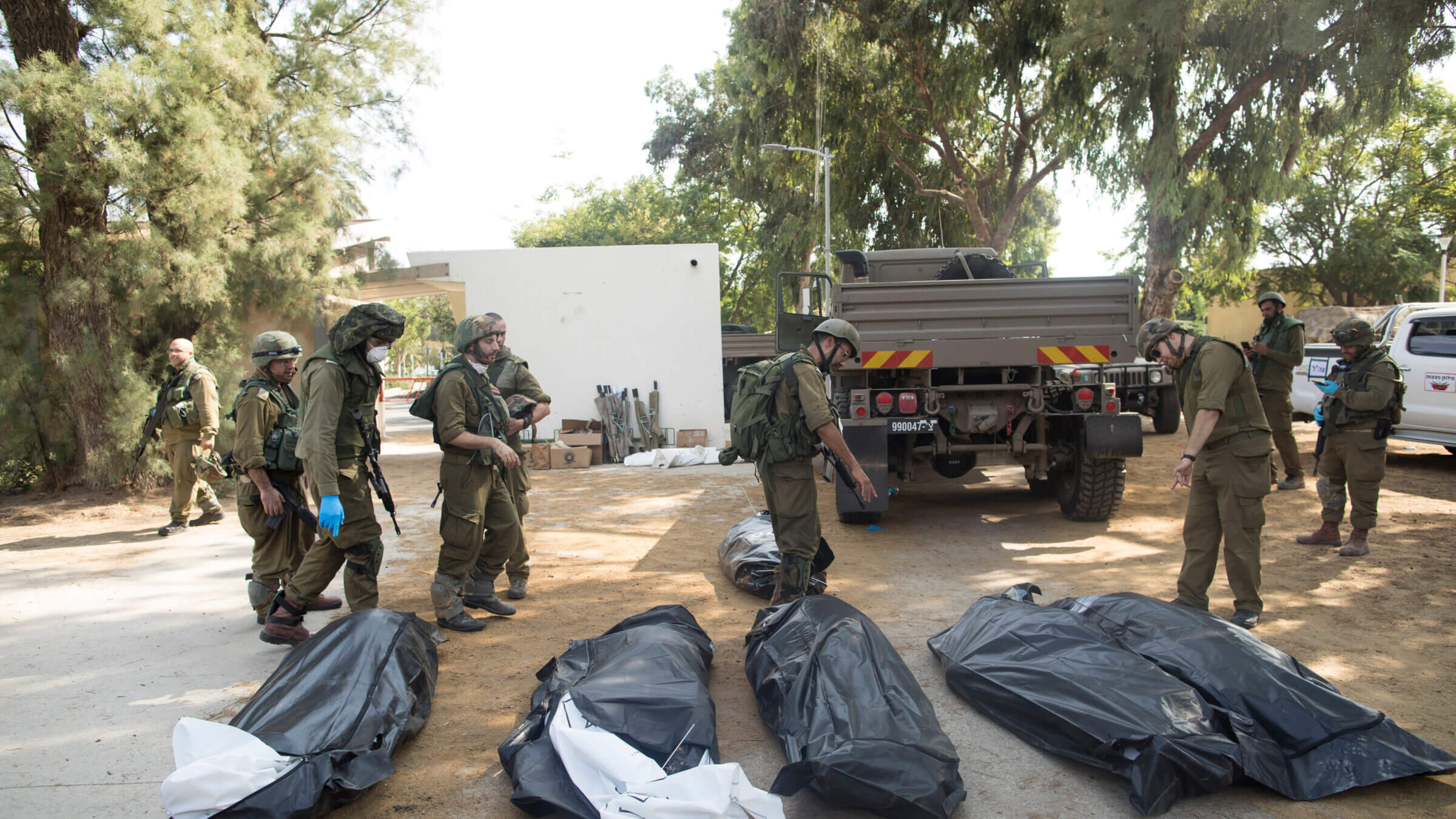Death toll in Israel attack soars past 1,200 as catalog of Hamas horrors is revealed
“It’s not a war or a battlefield; it’s a massacre,” one Israeli commander said about what he saw at Kibbutz Kfar Aza

Israeli soldiers remove the bodies of civilians, who were killed days earlier in an attack by Palestinian militants on this kibbutz near the border with Gaza on Tuesday. Photo by Getty Images
(JTA) — A pile of bodies at a bus stop. Burned corpses in a safe room. Entire families slaughtered together. A toddler’s room drenched in blood.
Four days after Hamas attacked Israel, emergency responders are still combing through the carnage at dozens of sites near Gaza. They are moving house by house, community by community, to recover the dead, identify the missing and, in a single bright incident on Tuesday, extract survivors.
The death toll in the attack vaulted to 1,200 early Wednesday as a result of the efforts, and Israeli social media networks alit with posts sharing that people who had hopefully been listed as missing had in fact died in the onslaught. There are so many dead that the army’s system for victim identification is overwhelmed. Funerals are taking place at all hours, even as rockets sometimes require their attendees to take cover.
The recovery is also laying bare the brutality inflicted upon the assault’s victims, with horrifying scenes unfolding across the region closest to the Gaza Strip. Journalists invited to Kfar Aza, a kibbutz that was besieged for days, said they saw “bodies everywhere,” including children and people with their hands bound or heads cut. In one widely shared but not independently confirmed tidbit, a reporter with an Israeli news channel said an IDF commander had told her that soldiers found “at least 40 babies killed.”
“It’s not a war or a battlefield; it’s a massacre,” Itai Veruv, an Israeli commander, told reporters, according to the New York Times. “It’s something I never saw in my life, something more like a pogrom from our grandparents’ time.”
At Kibbutz Be’eri, pictures showed homes burned to shells and heavily damaged in other ways. The kibbutz lost 108 people, 10% of its population. Reports suggested that Kfar Aza and other small communities had fared as badly or worse.
On Wednesday, Prime Minister Benjamin Netanyahu tweeted a picture of what appeared to be a toddler’s bed drenched in blood. “Hamas is worse than ISIS,” he wrote.
Tensions were starting to flare. One man whose family survived the attack at Kfar Aza launched into a tirade against Netanyahu and his allies on national TV. Israeli-American families of missing young adults held a press conference to call attention to what they said was a lack of care from the governments of both countries. A survivor from Kibbutz Nahal Oz said he would “never forgive” Netanyahu and army leaders who took so long to get to his family and so many others who narrowly escaped death.
Meanwhile, the IDF continued to hammer Gaza by air while amassing troops at its border for a possible ground invasion. Early Wednesday, Israel also bombed targets in Lebanon, where there is a fear that Hezbollah could be planning a second wave of attack. Rockets continued to target the south, with at least 12 people wounded in one strike in Ashkelon. And a shooting in the West Bank near Jerusalem left one Israeli wounded.
Negotiations were ongoing about whether a temporary wartime government would be formed to address the crisis.
This article originally appeared on JTA.org.
A message from our CEO & publisher Rachel Fishman Feddersen
I hope you appreciated this article. Before you go, I’d like to ask you to please support the Forward’s award-winning, nonprofit journalism during this critical time.
We’ve set a goal to raise $260,000 by December 31. That’s an ambitious goal, but one that will give us the resources we need to invest in the high quality news, opinion, analysis and cultural coverage that isn’t available anywhere else.
If you feel inspired to make an impact, now is the time to give something back. Join us as a member at your most generous level.
— Rachel Fishman Feddersen, Publisher and CEO